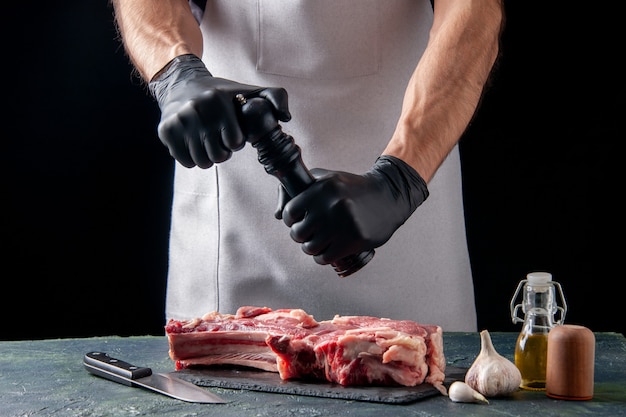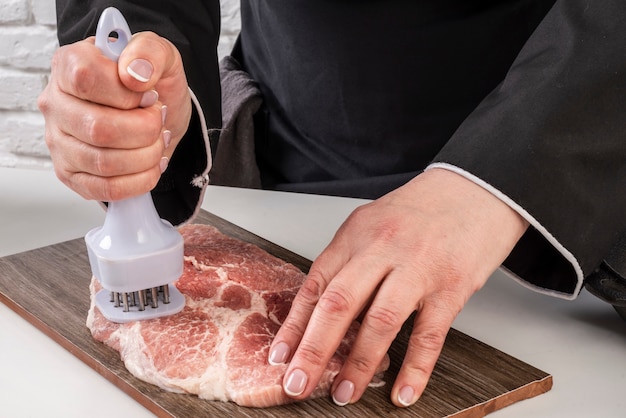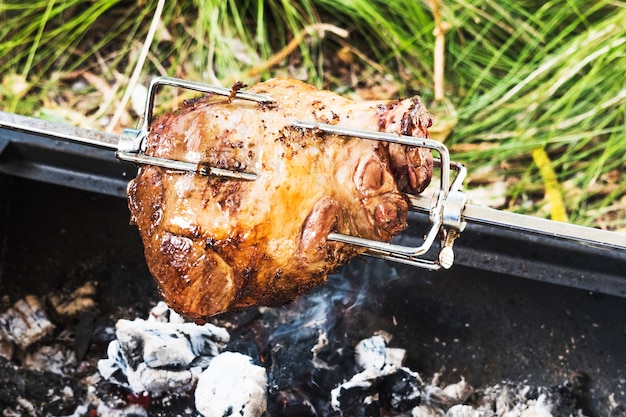As a seasoned cook, I've always held a special fondness for lamb. There's just something about its rich flavor and tender texture that makes my heart sing. But let's be honest, cooking lamb can be a bit of a culinary tightrope walk. Undercook it, and you're left with a chewy, tough mouthful. Overcook it, and you're facing dry, flavorless disappointment. But fear not, my fellow food enthusiasts! I'm here to share my years of experience and guide you to the ultimate lamb cooking temperatures, ensuring perfect doneness every time.
Part 1: Delving into the World of lamb cuts

The first step to mastering lamb cooking is understanding the different cuts and their unique characteristics. Each cut presents a distinct opportunity for culinary exploration, with its own ideal cooking methods.
1.1. The Shoulder: A Workhorse of Flavor
The lamb shoulder is a real culinary workhorse. It's perfect for roasting or slow cooking, offering a generous amount of fat marbling that results in incredibly tender and flavorful results. It's a cut that consistently delivers on its promise of rich, satisfying flavor.
1.2. The Leg: A Classic for Roasting
The lamb leg is a classic choice for roasting, particularly when you're catering to a crowd. It's leaner than the shoulder, demanding a bit more care during cooking to avoid dryness. But when done right, the lamb leg offers a wonderfully succulent and satisfying experience.
1.3. The Loin: A Delicate Treat
Loin chops are a real treat, prized for their tender texture and rich flavor. They're perfect for grilling, pan-frying, or even skewering. They offer a delicate, melt-in-your-mouth experience that's sure to impress.
1.4. The Rack: A Culinary Showstopper
A rack of lamb is a culinary showstopper, perfect for special occasions. It's made up of a collection of rib chops, presenting a beautiful, impressive display alongside its juicy, flavorful goodness. It's a dish that commands attention and delivers on the promise of pure culinary satisfaction.
1.5. The Shanks: Slow-Cooked Delights
Lamb shanks might be the tougher cuts of lamb, but they transform into tender, succulent delights when slow-cooked. Think of them as the perfect ingredient for hearty lamb stew or a fragrant, flavorful tagine. Their rich flavor and melt-in-your-mouth texture are worth the slow-cooking journey.
Part 2: Cracking the Code of Perfect Doneness

Now that you're familiar with the different cuts, it's time to delve into the temperature guidelines for achieving perfect lamb doneness. Remember, these are just guidelines, and your personal preference plays a key role in how you like your lamb cooked. But with this information, you'll be able to confidently navigate the world of lamb cooking temperatures.
2.1. Rare: A Taste of Tenderness
For those who prefer a rare finish, aim for an internal temperature of 125°F (52°C). The lamb will be slightly red in the center, with a tender and juicy texture. It's a perfect choice for those who enjoy a delicate, almost raw feel to their lamb.
2.2. Medium Rare: A Balanced Approach
This is my personal favorite, with an internal temperature of 130°F (54°C). The lamb will have a lovely pink center with a slightly firmer texture than rare, offering a satisfying balance of tenderness and cooked flavor.
2.3. Medium: A More Cooked Option
For those who prefer a more cooked lamb, aim for an internal temperature of 140°F (60°C). The lamb will have a light pink center, with a more tender texture than well-done but still offering a cooked flavor profile.
2.4. Well-Done: A Firm and Cooked Finish
If you prefer your lamb well-done, aim for an internal temperature of 150°F (66°C). The lamb will be brown throughout and have a firm texture, providing a fully cooked experience for those who prefer it that way.
Part 3: The Essential Arsenal for Lamb Cooking

Investing in a few key tools will make your lamb cooking journey smoother and more enjoyable. Here are my top recommendations for conquering the world of lamb cooking:
3.1. A meat thermometer: Your Reliable Guide
A meat thermometer is absolutely essential for ensuring accurate doneness. I swear by a digital thermometer with a probe. It's fast and reliable, providing instant readings and taking the guesswork out of achieving your desired level of doneness.
3.2. A Sharp Knife: Precision for Success
A good, sharp knife is crucial for trimming excess fat and portioning your lamb. A chef's knife or a boning knife will make the task effortless and efficient, helping you achieve a beautiful presentation and precise portions.
3.3. A roasting pan: The Foundation for Even Cooking
For roasting, a large, heavy-duty roasting pan is a must. Look for one with a rack to allow for even heat circulation, ensuring that your lamb cooks evenly and doesn't stick to the pan. It's a key component for achieving a perfectly roasted lamb.
3.4. A Grill Pan or Skillet: For Searing Perfection
For grilling or pan-frying, a heavy-duty grill pan or skillet is ideal. These tools will help achieve beautiful grill marks and ensure even cooking, creating a visually appealing and flavorful lamb dish. They're essential for those who love a crispy, seared exterior.
3.5. A dutch oven: For Slow-Cooked Delights
If you're planning to braise or slow cook your lamb, a Dutch oven is your best friend. It's incredibly versatile and helps create succulent and flavorful dishes, perfectly suited for the slow cooking process that transforms tougher cuts into tender, mouthwatering masterpieces.
Part 4: Essential Tips for Lamb Cooking Success
Here are some tips and tricks I've learned over the years, which will help you create perfect lamb every time. They're the secrets to transforming your lamb cooking from good to great.
4.1. Seasoning: Elevating the Flavor
Don't be afraid to experiment with different seasonings for your lamb. Fresh herbs like rosemary, thyme, and mint work beautifully, as do garlic, onion, and peppercorns. You can also try combinations of spices, citrus zest, and even a touch of chili flakes for added depth. There's a whole world of flavors waiting to be explored with lamb.
4.2. Resting: Letting the Flavors Settle
It's important to let your cooked lamb rest for 10-15 minutes before carving. This allows the juices to redistribute throughout the meat, resulting in a more tender and flavorful dish. It's a simple step that makes a significant difference in the overall quality of your lamb.
4.3. Avoid Overcooking: The Key to Tenderness
The key to perfect lamb is to avoid overcooking. Overcooked lamb will be dry and tough, a culinary tragedy that can be avoided with careful attention. Use a meat thermometer to ensure it's cooked to your desired doneness, and pull it from the heat just before reaching the desired temperature. Lamb will continue to cook slightly as it rests.
4.4. Fat Matters: Flavor and Tenderness
Lamb is a fatty meat, and that's a good thing! The fat adds flavor and tenderness, contributing significantly to the overall richness and satisfaction of the dish. Leave a thin layer of fat on your lamb when cooking to ensure it stays juicy and flavorful. You can trim excess fat before cooking, but don't remove it all.
4.5. Slow and Low: The Art of Patience
For tougher cuts of lamb, like the shank, slow cooking is the way to go. This allows the connective tissue to break down, resulting in a melt-in-your-mouth texture. Patience is key here, but the reward is a truly tender and flavorful lamb dish.
Part 5: lamb recipes: A culinary adventure
Now, let's get into some delicious lamb recipes that will inspire your inner chef. These recipes are a starting point for your own culinary adventures with lamb. They demonstrate different cooking methods and flavor profiles, allowing you to explore the versatility of this beautiful meat.
5.1. Roasted Leg of Lamb with Rosemary and Garlic: A Classic for a Reason
This is a classic for a reason. The rosemary and garlic add a wonderful depth of flavor to the lamb, while the roasting process creates a crispy exterior and tender interior. It's a simple recipe that consistently delivers on its promise of flavor and satisfaction. Here's the breakdown:
- Preheat your oven to 350°F (175°C).
- Season your leg of lamb with salt, pepper, rosemary, and garlic. For an extra flavor boost, consider making a simple herb paste by mincing the rosemary and garlic together with a little olive oil.
- Roast the lamb for 1 hour and 15 minutes, or until it reaches an internal temperature of 140°F (60°C) for medium. You can adjust the cooking time based on the size of your leg of lamb.
- Let the lamb rest for 10-15 minutes before carving. This allows the juices to redistribute, ensuring a perfectly tender and flavorful final result.
5.2. grilled lamb chops with Mint Sauce: A Summertime Delight
These lamb chops are bursting with flavor and perfect for a summer barbecue. The mint sauce adds a refreshing touch that complements the rich lamb perfectly. Here's how to grill them to perfection:
- Preheat your grill to medium-high heat.
- Season the lamb chops with salt, pepper, and your favorite herbs. Try a simple combination of thyme and rosemary, or get creative with a blend of Mediterranean herbs.
- Grill the lamb chops for 4-5 minutes per side, or until they reach an internal temperature of 130°F (54°C) for medium rare.
- Let the lamb chops rest for 5 minutes before serving with mint sauce. The resting time allows the juices to redistribute, ensuring a tender and flavorful final product.
5.3. Lamb Tagine with Apricots and Almonds: A Journey to Morocco
This is a fragrant and flavorful tagine that will transport you to Morocco. The combination of apricots and almonds adds a touch of sweetness and richness to the dish, creating a harmonious blend of flavors. Here's how to create this culinary masterpiece:
- Brown the lamb shanks in a Dutch oven with olive oil. This step develops a flavorful crust on the lamb, adding to the overall richness of the dish.
- Add onions, garlic, ginger, and spices like cumin, turmeric, and cinnamon. These aromatic ingredients create a complex and fragrant base for the tagine.
- Add diced apricots, almonds, and chicken broth. The apricots provide sweetness, while the almonds add texture and a nutty flavor. The chicken broth ensures a flavorful and moist cooking environment for the lamb.
- Cover the Dutch oven and simmer for 2-3 hours, or until the lamb is tender. Slow cooking allows the lamb shanks to become incredibly tender, falling off the bone with ease.
- Serve the lamb tagine with couscous or rice. The couscous or rice acts as a perfect accompaniment to the flavorful and succulent lamb tagine, soaking up the delicious sauce and creating a satisfying and balanced meal.
Part 6: Storing and Reheating Lamb: Preserving Flavor and Texture
Leftover lamb? No problem! Here's how to store and reheat it without compromising its flavor and texture. These tips will ensure that your leftover lamb remains delicious and enjoyable.
6.1. Storing: Keeping It Fresh
Store cooked lamb in the refrigerator for up to 3-4 days. Be sure to cover it tightly to prevent drying out. You can also freeze cooked lamb for up to 3 months. When freezing, use a freezer-safe container or wrap it tightly in plastic wrap and aluminum foil. This will help preserve the flavor and texture of the lamb.
6.2. Reheating: Bringing Back the Flavor
The best way to reheat lamb is in the oven or microwave. Reheat the lamb in a preheated oven at 350°F (175°C) for 15-20 minutes, or until heated through. You can also reheat lamb in the microwave, but be sure to cover it with a damp paper towel to prevent drying out.
Part 7: Lamb Nutrition: A Nutrient-Packed Choice
Lamb is a great source of protein and other essential nutrients. A 3-ounce serving of cooked lamb provides about 20 grams of protein, along with iron, zinc, and B vitamins. Lamb is also a good source of omega-3 fatty acids. It's a versatile and nutritious addition to a balanced diet.
Part 8: FAQs: Addressing Your Questions
Here are some frequently asked questions about cooking lamb. These answers will help you navigate common challenges and questions about lamb cooking.
8.1. Can I cook lamb from frozen?
It's not recommended to cook lamb from frozen. The lamb will take longer to cook, and it may not be as evenly cooked. It's best to thaw lamb in the refrigerator overnight before cooking. This ensures that the lamb cooks evenly and reaches the desired doneness without being dry or tough.
8.2. What is the best way to trim lamb fat?
Use a sharp knife to trim any excess fat from the lamb. Leave a thin layer of fat on the lamb for flavor and tenderness. Trim away any excess fat that might be tough or overly thick, but avoid removing all of the fat, as it contributes to the overall flavor and juiciness of the lamb.
8.3. How can I make lamb more tender?
To make lamb more tender, you can use a meat mallet to pound it or marinate it in acidic ingredients like lemon juice or yogurt. You can also slow cook tougher cuts of lamb to break down the connective tissue. These methods help to tenderize the meat, creating a more enjoyable eating experience.
8.4. What are some good side dishes for lamb?
Some great side dishes for lamb include roasted vegetables, couscous, rice, and potatoes. You can also serve lamb with a sauce like mint sauce or chimichurri sauce. These side dishes complement the flavor and richness of the lamb, creating a balanced and satisfying meal.
8.5. What wine pairs well with lamb?
Red wines, such as Cabernet Sauvignon, Merlot, and Shiraz, pair well with lamb. You can also enjoy lamb with a full-bodied white wine like Sauvignon Blanc. The tannins in red wine help to cut through the richness of the lamb, creating a harmonious flavor combination.
Part 9: Conclusion: Embrace the Journey of Lamb Cooking
Mastering lamb cooking temperatures is all about understanding the different cuts, using the right tools, and embracing the journey of experimentation. With this guide, you're equipped with the knowledge and confidence to cook lamb like a pro. So, grab your favorite lamb cut, gather your culinary tools, and embark on a delicious adventure in the world of lamb cooking. Enjoy!
Everyone is watching

Perfect Rice Every Time: The Ultimate Guide to Cooking Rice
Cooking TipsAs a self-proclaimed foodie, I've always been a bit obsessed with rice. It's the foundation of countless cuisi...

The Ultimate Guide to Cooking Asparagus: Tips, Techniques, and Recipes
Cooking TipsAsparagus. The mere mention of this spring delicacy conjures up images of vibrant green spears, crisp and burs...

Ultimate Guide to Cooking the Perfect Thanksgiving Turkey
Cooking TipsThanksgiving. Just the word conjures up images of overflowing tables laden with delicious food, the scent of r...

Prime Rib Roast Cooking Time Chart: Per Pound Guide
Cooking TipsPrime rib roast. Just the name conjures images of lavish dinners, crackling fires, and hearty laughter. It’s ...

How Long to Bake Potatoes in the Oven (Perfect Every Time)
Cooking TipsBaked potatoes are a staple in my kitchen. They're incredibly versatile, delicious, and surprisingly easy to m...
